Masterpiece Story: L.O.V.E. by Maurizio Cattelan
In the heart of Milan, steps away from the iconic Duomo, Piazza Affari hosts a provocative sculpture by Maurizio Cattelan. Titled...
Lisa Scalone 8 July 2024
Gerrit Dou’s Dog at Rest is a masterpiece of Dutch genre painting, perfect for both dog enthusiasts and art lovers.
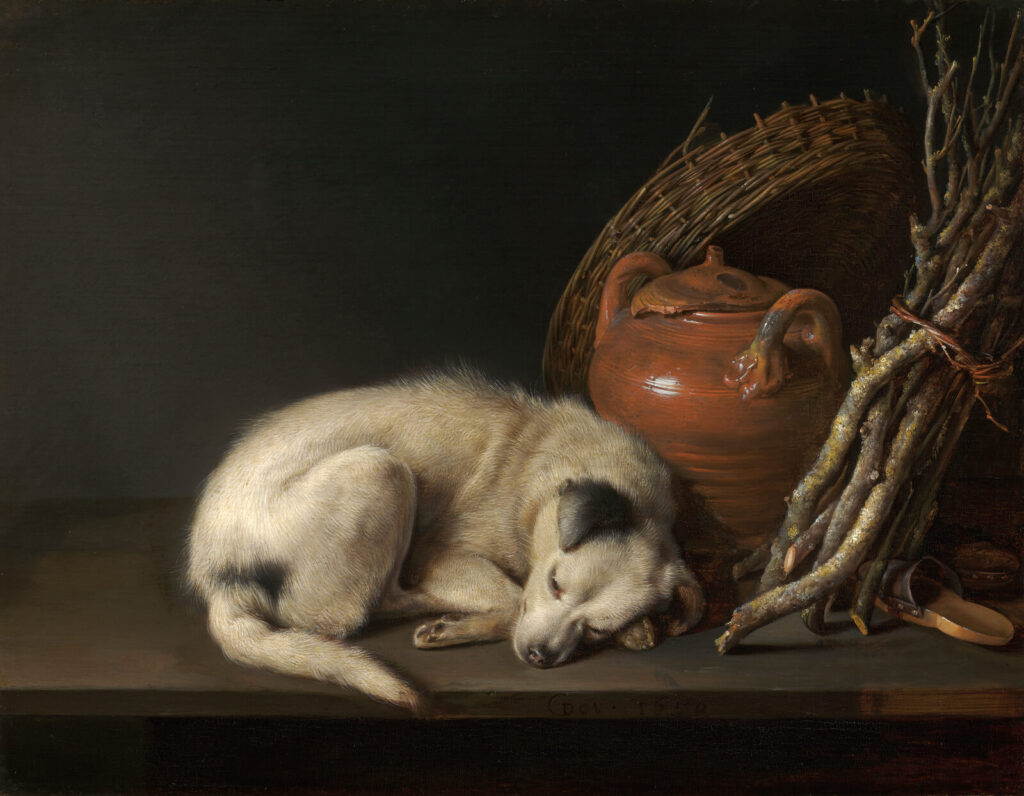
Gerrit Dou, Dog at Rest, 1650, Museum of Fine Arts, Boston, MA, USA.
Gerrit Dou (1613-1675) was an artist who lived and worked in Leiden, Netherlands during the Dutch Golden Age. At age 13, Dou studied under the 20-year-old Rembrandt van Rijn (1606-1669) at Rembrandt’s studio where Dou developed and refined his talent. By the 1660s, he was the premier painter of the city when he achieved international fame and attention from King Charles II of England and Grand Duke Cosimo III de’ Medici of Tuscany.
Gerrit Dou developed a reputation as a master painter of small domestic scenes, known as genre paintings, that exhibit great realism of texture, shadows, and color. Dou’s paintings have a great touchability where viewers feel as if they can reach out and touch the subjects. Such a reaction is strongly felt in Dou’s masterpiece, Dog at Rest. Who does not want to pet and stroke the adorable dog?
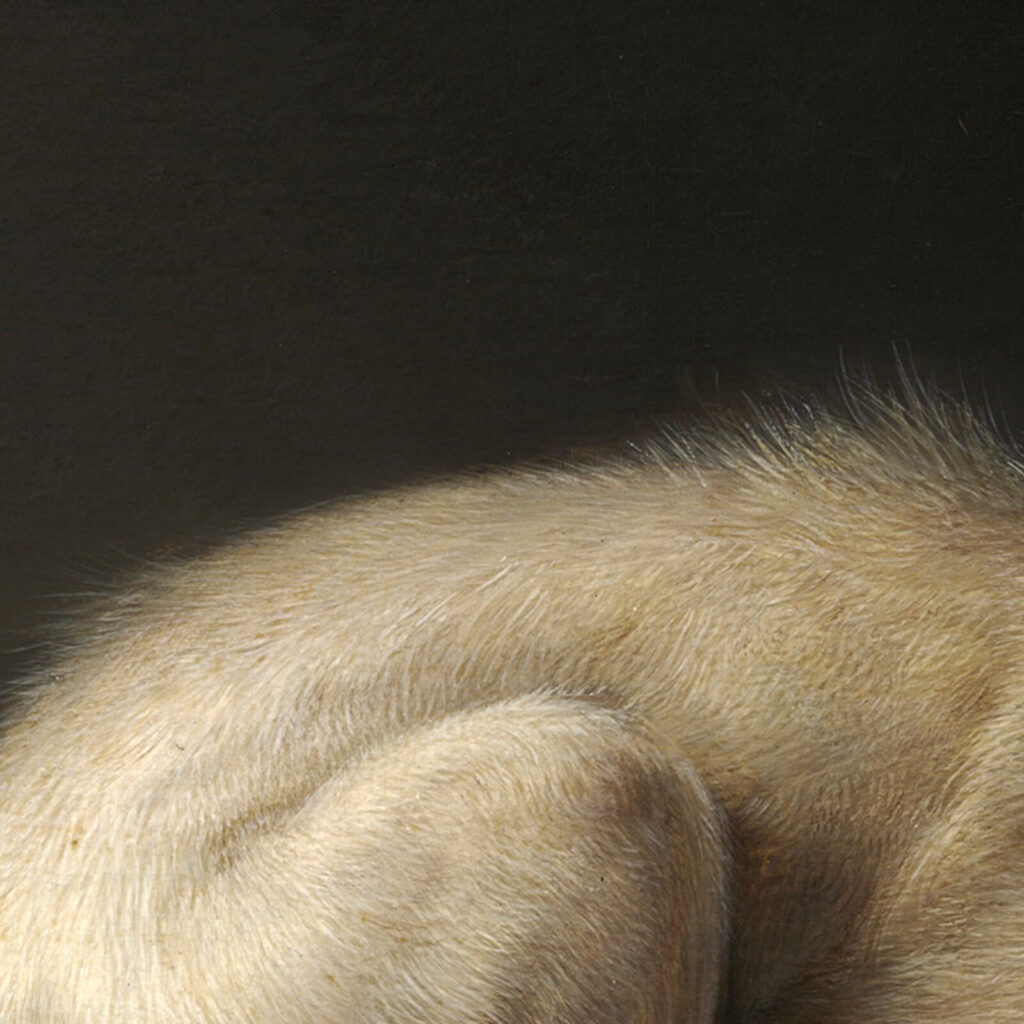
Gerrit Dou, Dog at Rest, 1650, Museum of Fine Arts, Boston, MA, USA. Detail.
Dog at Rest was painted in 1650 as a very small oil on an oak wood panel. It measures a diminutive 16.5 x 21.6 cm (6 1/2 x 8 1/2 in.). Therefore, the image is almost considered a miniature. The image is a classic genre painting but displays an ordinary domestic scene. Gerrit Dou did not embrace grand images inspired by history or religion. He seized simple and powerful emotions such as domestic comfort, intimacy, and pet love. Therefore, Dog at Rest does not have illusions of grandeur. It is an understated depiction of a small white dog resting against a clay jar, a bundle of twigs, and a wicker basket. It is a snapshot of an unimportant but easily relatable moment for any viewer, especially pet owners.
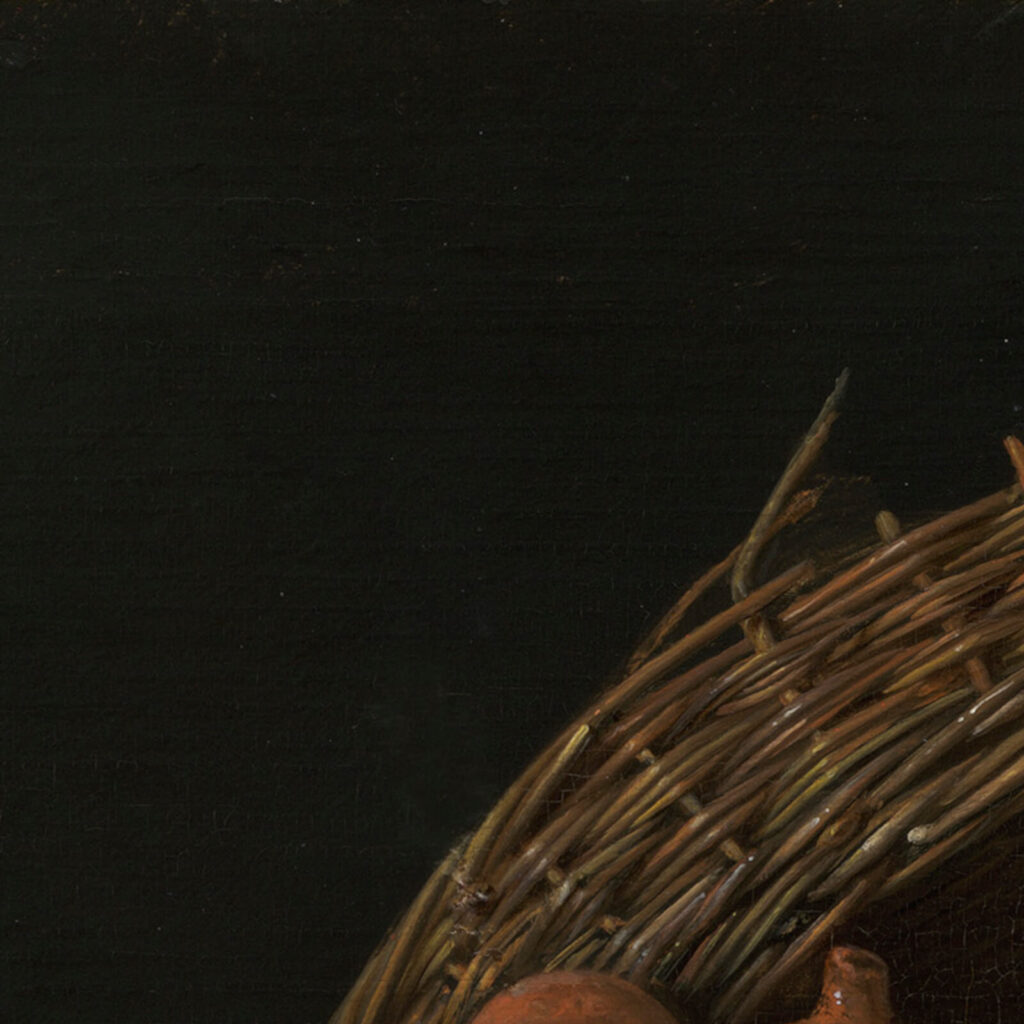
Gerrit Dou, Dog at Rest, 1650, Museum of Fine Arts, Boston, MA, USA. Detail.
The small dog dominates the composition. It is half awake with eyes half closed. Tired, but resisting sleep. The dog’s fur is almost entirely cream-colored except for one black ear, a small black patch above the tail, and a black circle around the nose. The dog is curled into a ball with its head resting on its front paws. A slight ripple of skin across the shoulders further implies the curled and contracted position. The dog’s body forms an almost oval outline that echoes the round outlines of the clay jar and the wicker basket.
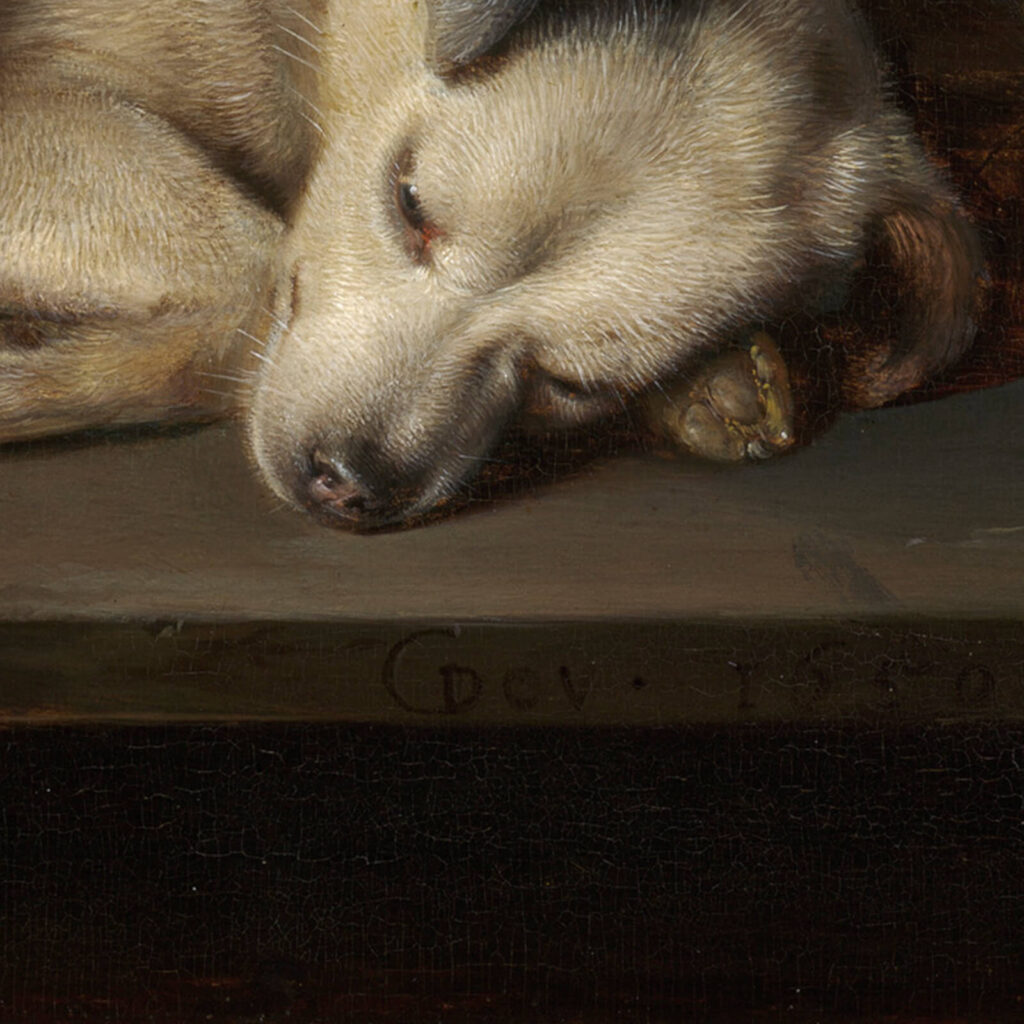
Gerrit Dou, Dog at Rest, 1650, Museum of Fine Arts, Boston, MA, USA. Detail.
Many art historians believe that Gerrit Dou was deeply inspired by his teacher, Rembrandt, when he created Dog at Rest because there are visual similarities among the painting and two earlier images created by Rembrandt. The compositions and contexts are different, but the essential form of a sleepy curled dog is apparent.
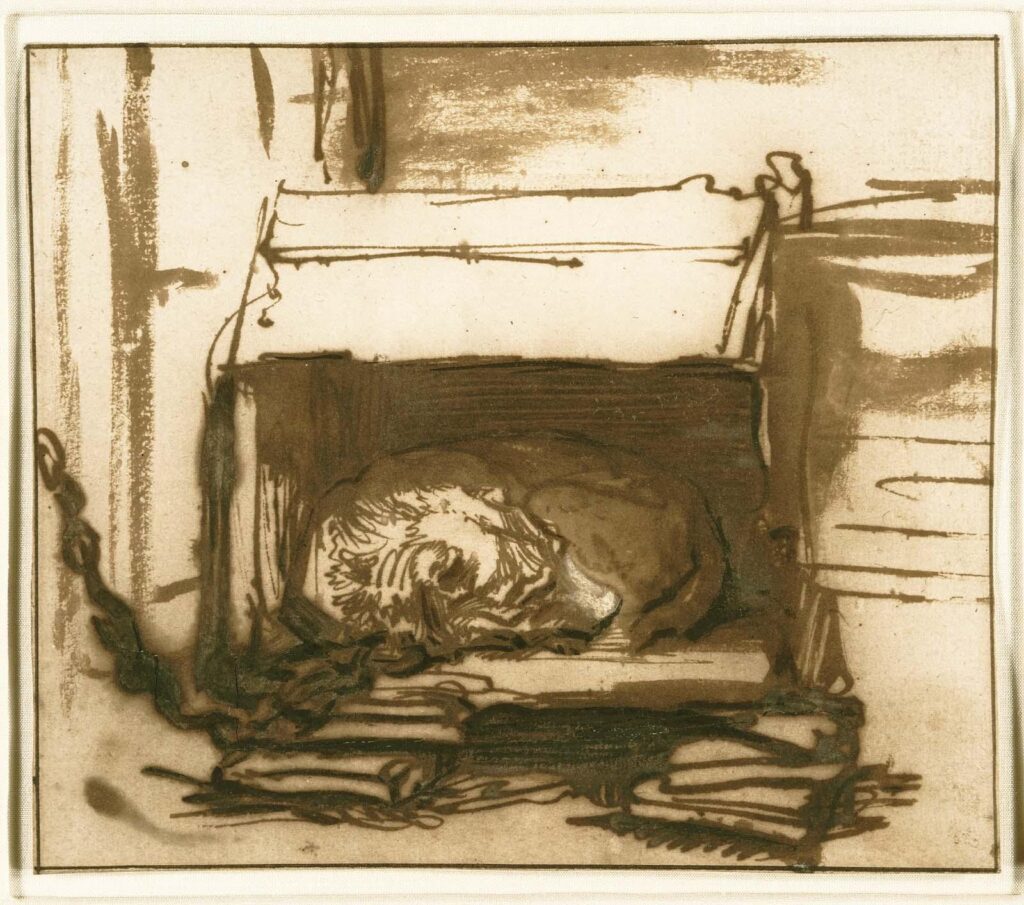
Rembrandt Harmensz van Rijn, Sleeping Watchdog, 1637-1640, Museum of Fine Arts, Boston, MA, USA.
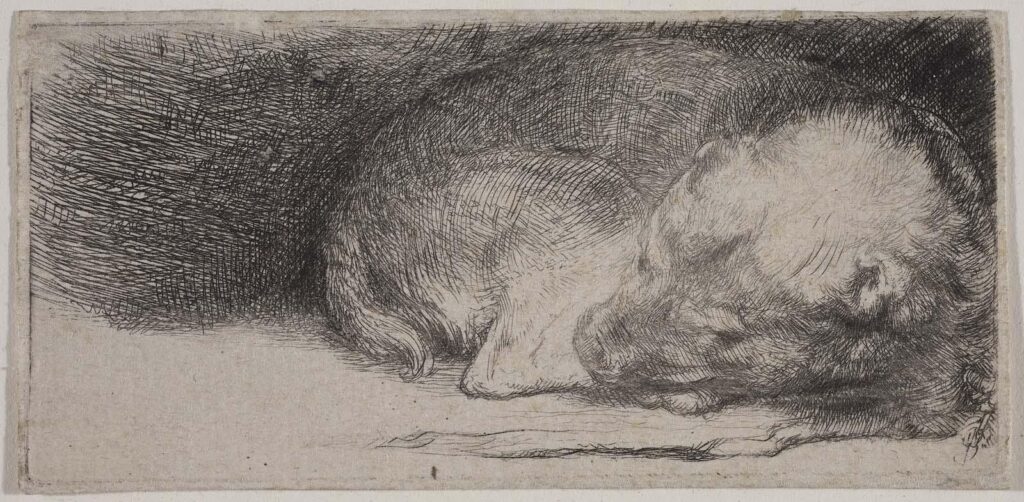
Rembrandt Harmensz van Rijn, Sleeping Puppy, ca 1640, Museum of Fine Arts, Boston, MA, USA.
If Gerrit Dou did not take direct inspiration from Rembrandt, he definitely took direct inspiration from one of his own earlier works. The motif of a sleepy dog next to a clay jar is easily found in the bottom right corner of his Spinner’s Prayer, circa 1645, now found in the Alte Pinakothek in Munich, Germany.
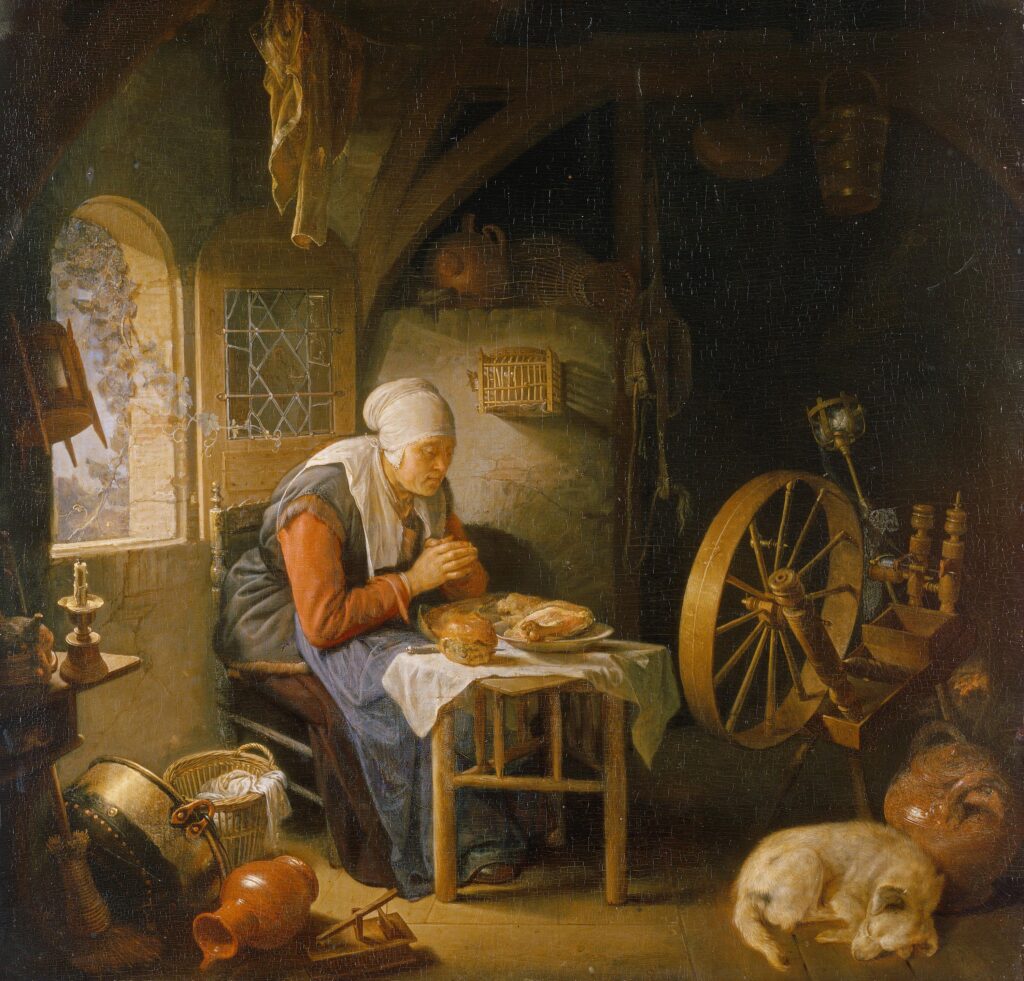
Gerrit Dou, Spinner’s Prayer, ca 1645, oil on oak panel, Alte Pinakothek, Munich, Germany.
His Spinner’s Prayer was painted five years before Dog at Rest, therefore it is easily proposed that Gerrit Dou experimented with the resting dog motif as a supporting detail in Spinner’s Prayer and then later made it the primary subject in Dog at Rest. Hence, an artistic evolution is discovered, when comparing the works of Rembrant and Dou, from inspiration, then detail, and finally subject.
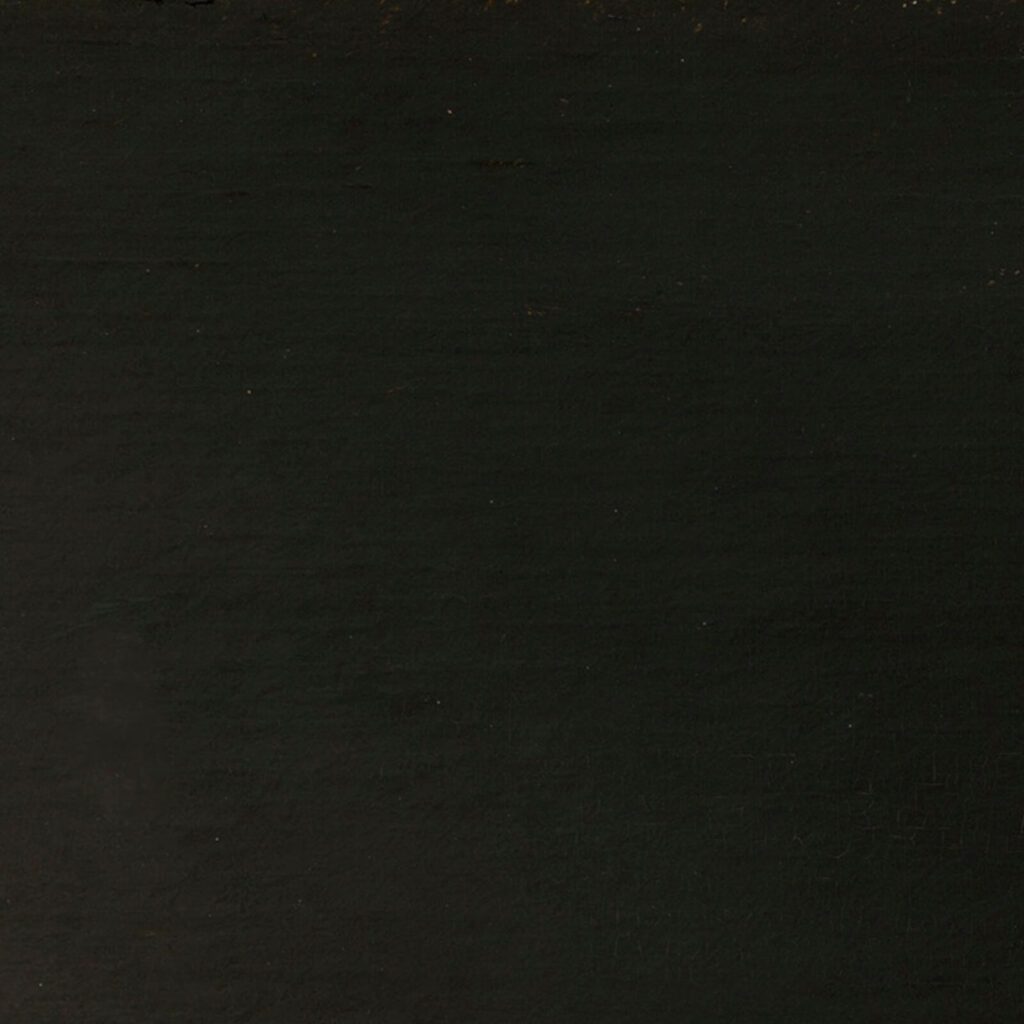
Gerrit Dou, Dog at Rest, 1650, oil on oak panel, Museum of Fine Arts, Boston, MA, USA. Detail.
How is the dog and the surrounding objects painted with such a realistic illusion? The answer lies in the timely technique of applying many thin layers of glaze. Gerrit Dou, like many other Dutch painters, could apply up to 10-15 glazes to build and develop their subjects. The many layers of glaze allow light to infiltrate and bounce creating luminosity and texture from within the subjects.
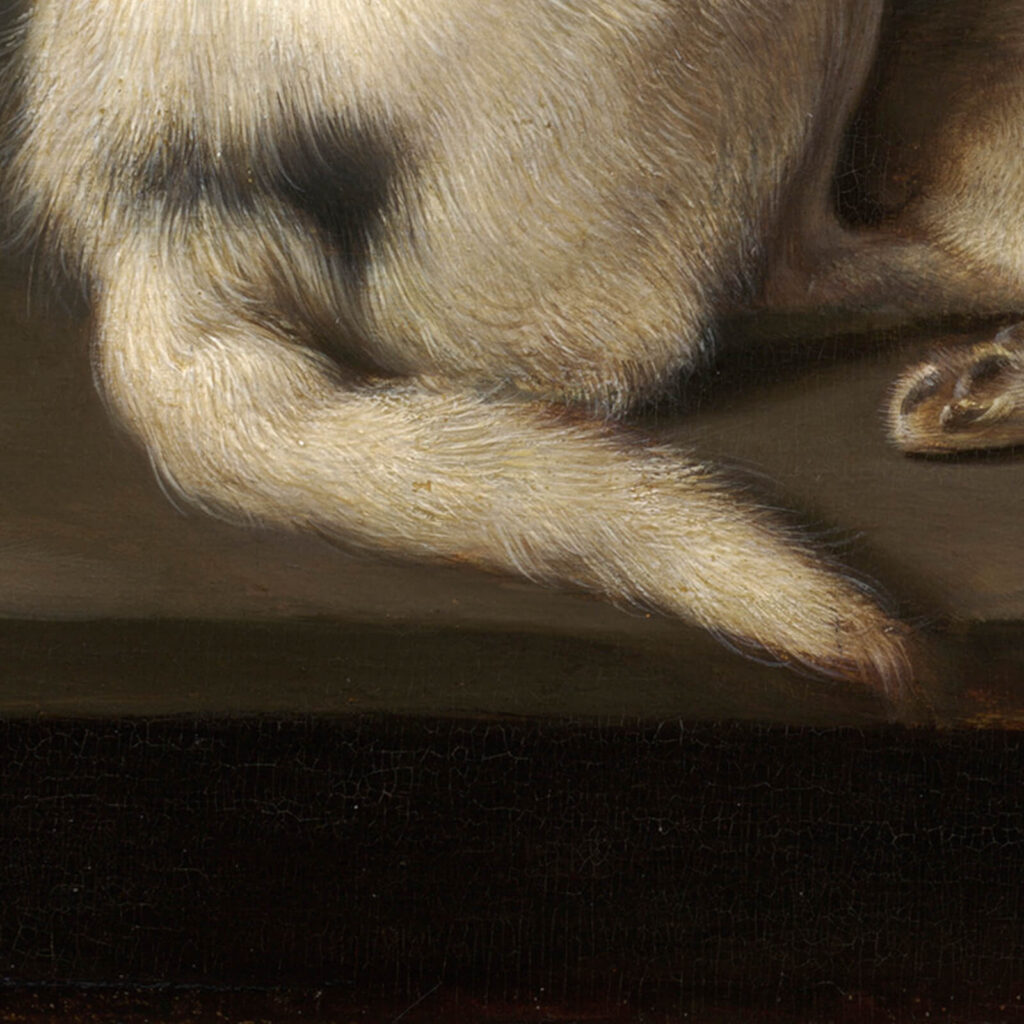
Gerrit Dou, Dog at Rest, 1650, Museum of Fine Arts, Boston, MA, USA. Detail.
To the right of the dog is a terracotta clay pot. It has a broken lid with dark worn patches on its handles. The jar is old and has been frequently used. However, Gerrit Dou infuses an almost humble nobility to the jar with its noble simplicity, utility, and purpose. The jar is not a frivolous object but a functional well-used item. Its dull worn handles contrast with its glossy polished shoulder which reflects a patch of white light above the dog’s head.
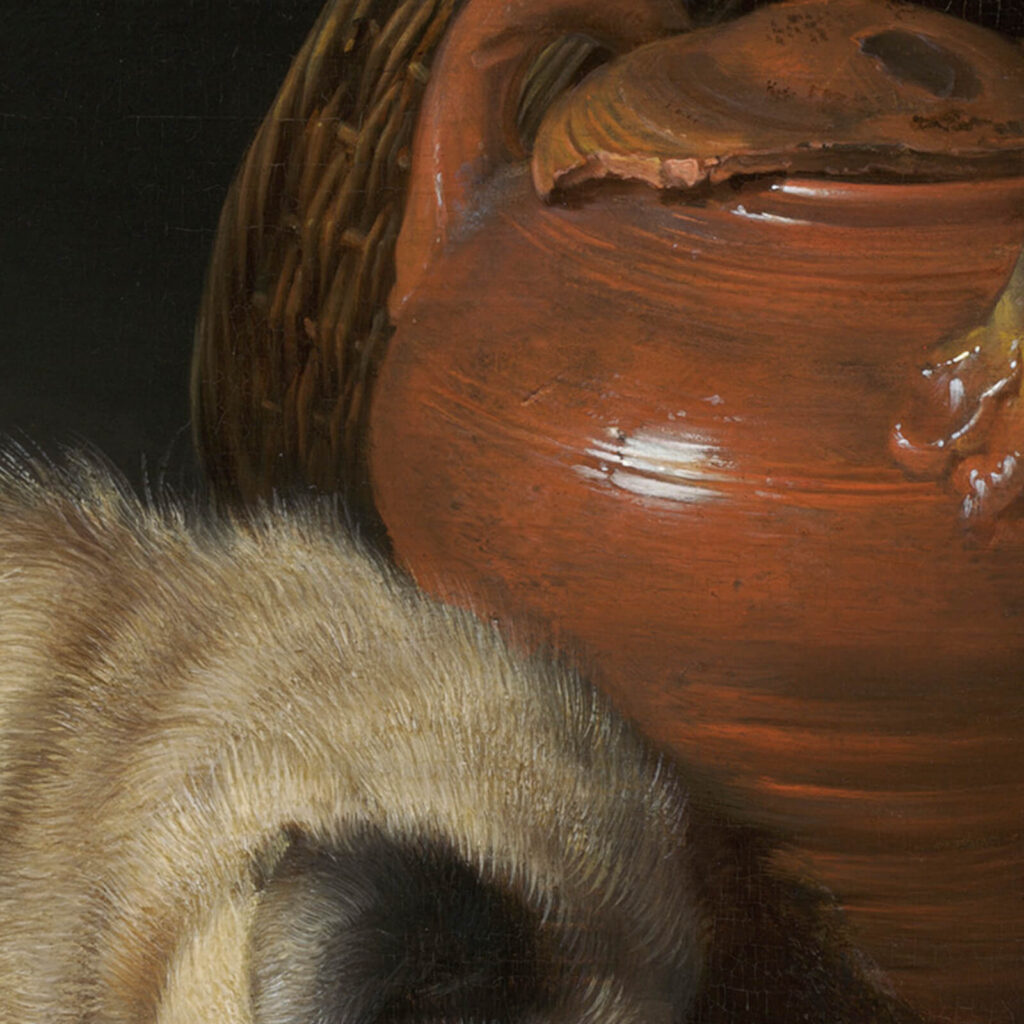
Gerrit Dou, Dog at Rest, 1650, Museum of Fine Arts, Boston, MA, USA. Detail.
To the further right of the jar is a bunch of branches. The twigs appear to be some variety of birch which is commonly found on Continental Europe. The branches are bundled and tied with twine. Perhaps this is a parcel of kindling wood to start a fire? Perhaps this stored kindling wood indicates that this scene is located in a basement or cellar? Most people store their kindling wood in such a domestic space, and that would also explain the location of the broken-lidded jar. It is still usable, and therefore too good to discard, but it is too shabby to have displayed in the main living spaces of the home.
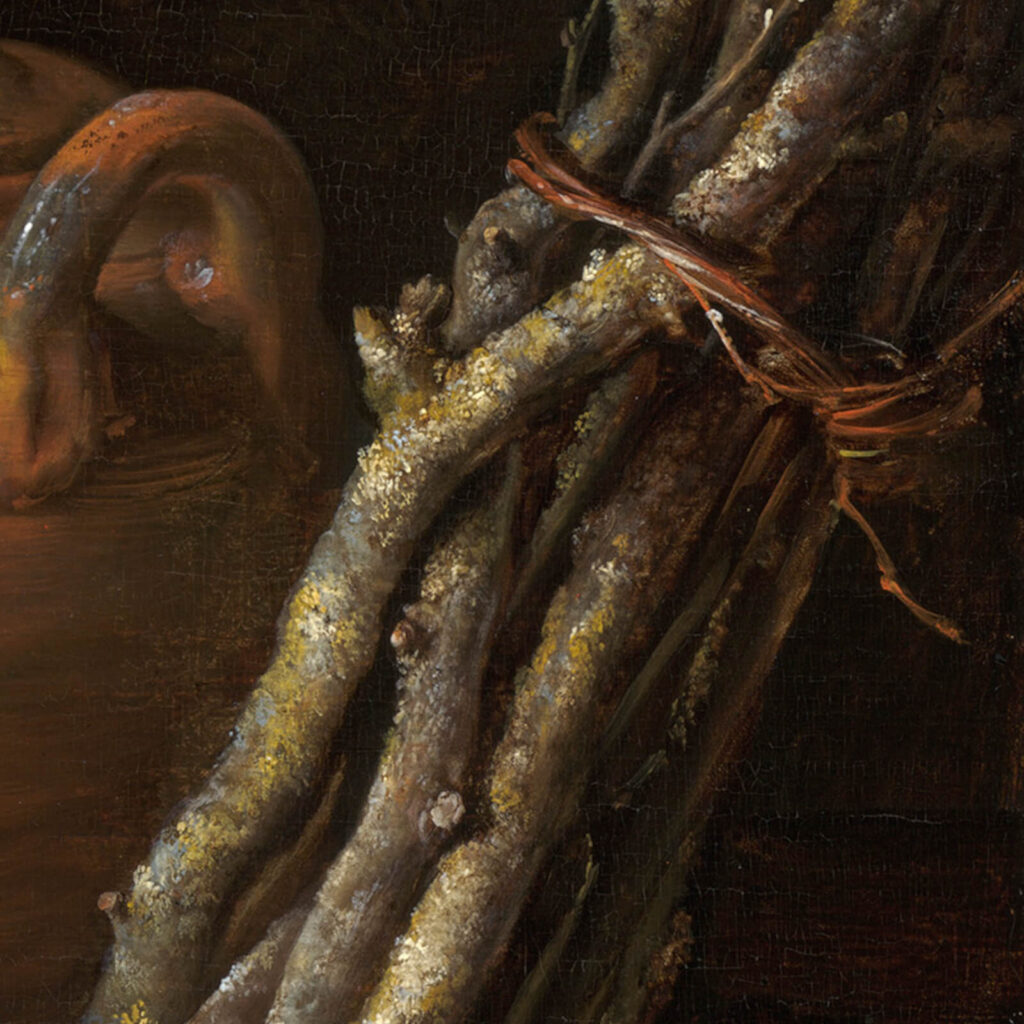
Gerrit Dou, Dog at Rest, 1650, Museum of Fine Arts, Boston, MA, USA. Detail.
Further along the right of the shelf or tabletop, is a single house slipper or perhaps a clog shoe made of a wood sole and a leather upper. Most dog owners can relate to their dogs secretly taking something and converting it into a new toy. Sometimes these new “toys” can be valuable items that the dog owner later laments their ruin. Perhaps the viewer is witnessing the evidence of a canine crime. This mischievous dog has swiped a slipper/shoe, carried it to its secret spot in the basement/cellar, has chewed on it for amusement, and now has decided to take a quick rest. Using dog psychology, this theory makes sense to explain the visual composition of the painting, because who stores one slipper/shoe on a shelf? It is not logical, not hygienic, and not good housekeeping. Yes, the cute dog must be the culprit for the case of the missing slipper!
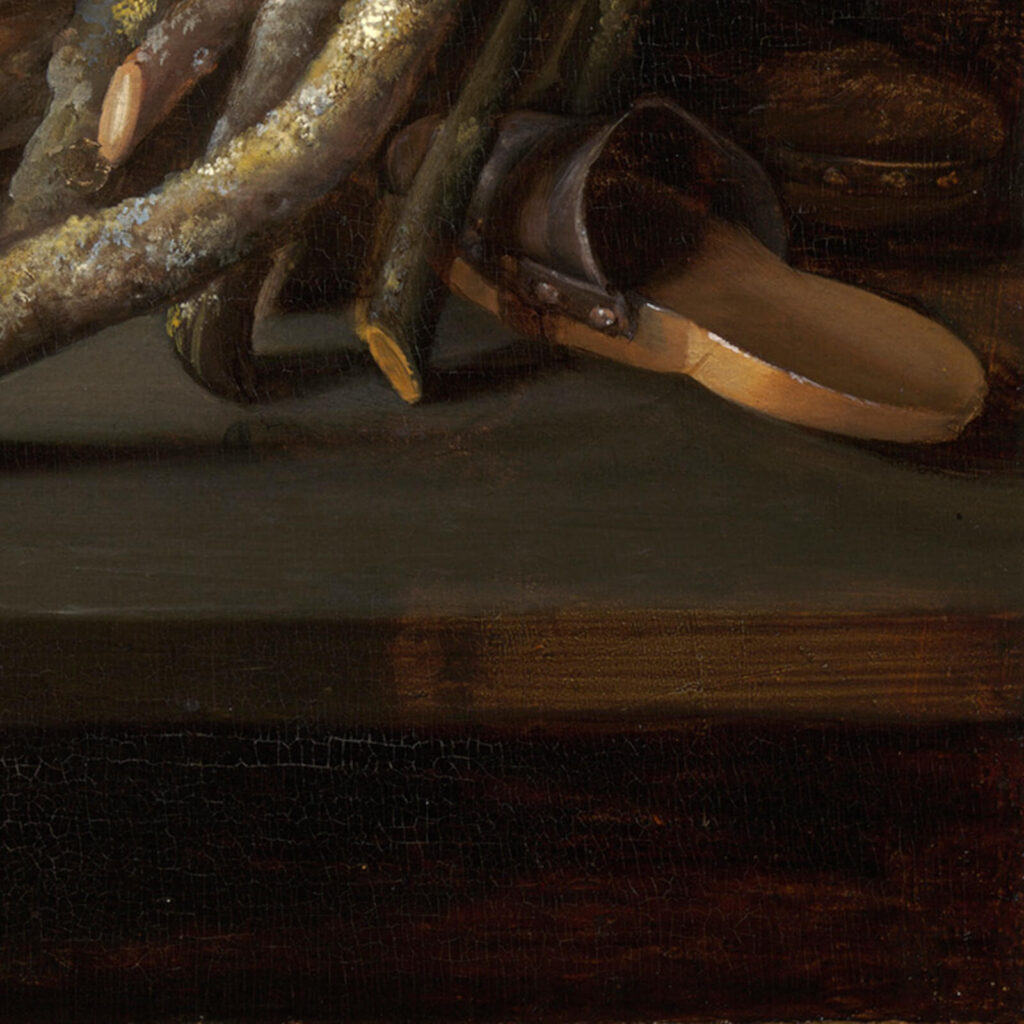
Gerrit Dou, Dog at Rest, 1650, Museum of Fine Arts, Boston, MA, USA. Detail.
There is a wicker basket behind the dog, a jar, twigs, and a shoe. It leans against the jar in a Titanic-like tilt. Like the tragic ship, the basket is also in ruins with a frayed upper edge where the rim is missing and the vertical stakes roughly poke above the basket’s body. This basket is in the first stages of unraveling. It is at the beginning of disuse. It may still be used to hold something, but its days are numbered. This broken basket is another clue to the basement or cellar as the dog’s sleepy location. Like the jar, the basket still has some use left, but it is no longer presentable in the main rooms of the house. It represents the Dutch bourgeoisie’s praise for thriftiness in their everyday lives. Make do and mend. Perhaps the basket and jar are being kept until they can be mended during a free afternoon? Modern thrifty people can relate to such a concept. It is amazing what a little bit of time, glue, and sewing can do to extend the life of domestic items and save replacement money.
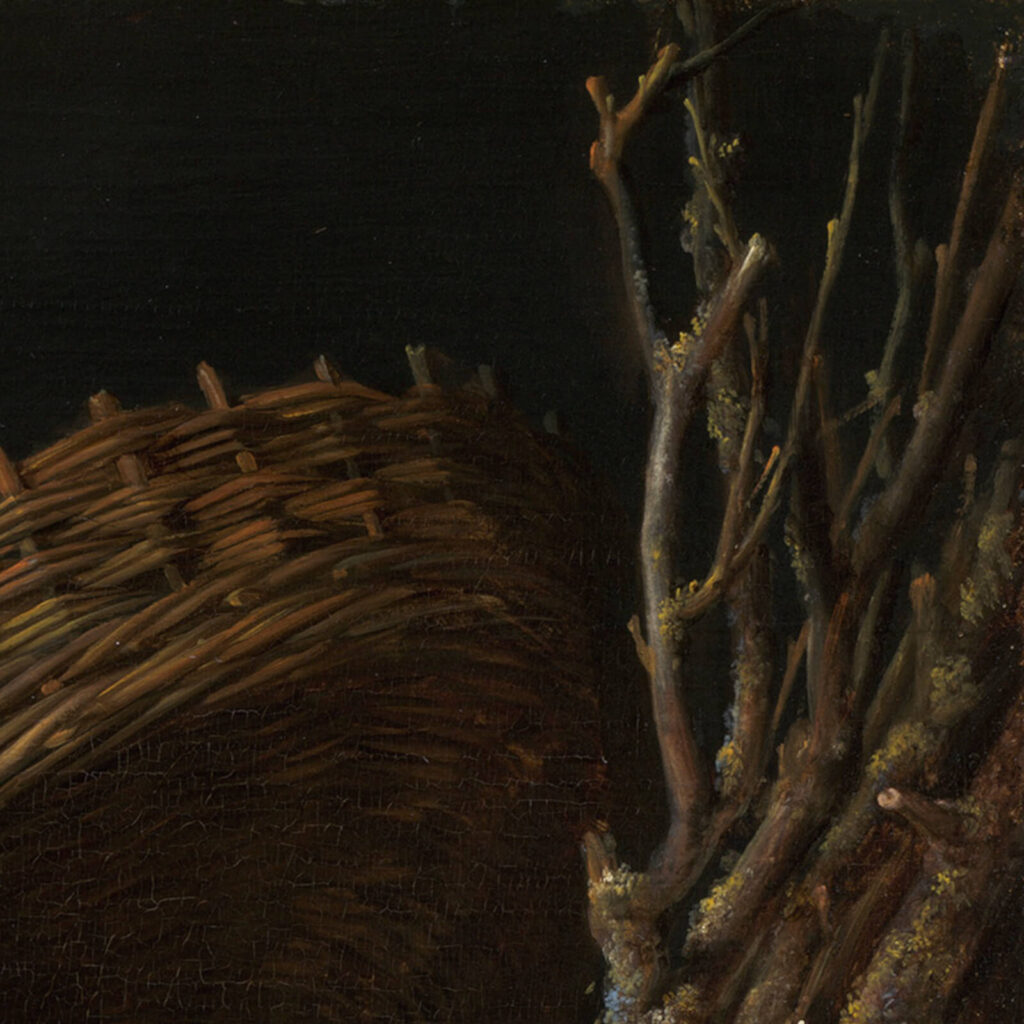
Gerrit Dou, Dog at Rest, 1650, Museum of Fine Arts, Boston, MA, USA. Detail.
Gerrit Dou was clearly a master painter of textures and forms. Dog at Rest presents subjects of fur, clay, wood, and leather. Dou captures their individual essences through his light and coloring. It is expertly done. What is furthermore interesting is the off-balanced composition. Everything is slid to the right side. The painting is heavily dominated in the bottom right corner while the top left corner is a contrasting void. This off-balance, highlighted with a red line, creates visual interest because the painting is not a boring line-up of objects on a shelf. It is a dynamic collection against a stark background.
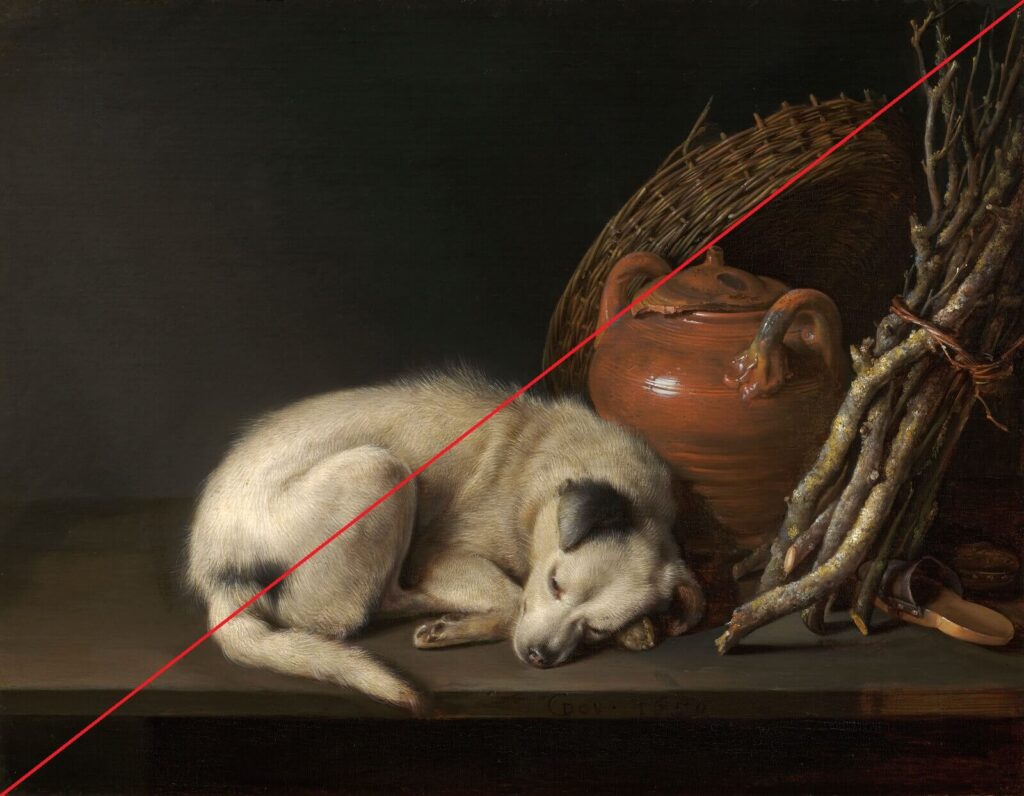
Red Composition Overlay. Gerrit Dou, Dog at Rest, 1650, oil on oak panel, Museum of Fine Arts, Boston, MA, USA. Detail.
Would Gerrit Dou’s Dog at Rest be such an interesting and compelling painting without the dog? Would viewers admire the painting as much if Dou had placed a bowl of bright lemons instead of a sleepy canine? Probably and most certainly not. The dog is the star of the painting. There are hundreds of thousands of Dutch still-lifes in the world. Countless paintings of fruit, flowers, and cookery objects fill rooms of museums and grace the walls of wealthy homes and offices. However, not many artists attempted such a “still life” like painting with a dog. Hence, Gerrit Dou’s Dog at Rest feels fresh and novel in the Dutch Golden Age art world. People typically and emotionally connect more with animals than with bowls of fruit or vases of flowers. People can easily love an animal, but not many people affectionately love an apple or an amaryllis.
Baer, Dr Ronni. “Sleeping Dog.” Christie’s, May 25, 2005.
“Dog at Rest.” Collection. Museum of Fine Arts, Boston, MA, USA. Retrieved 31 January 2024.
“Sleeping Puppy.” Collection. Museum of Fine Arts, Boston, MA, USA. Retrieved 31 January 2024.
“Sleeping Watchdog.” Collection. Museum of Fine Arts, Boston, MA, USA. Retrieved 31 January 2024.
Smee, Sebastian. “Masterful Mutt.” Washington Post, November 13, 2019.
“Spinner’s Prayer.” Collection. Alte Pinakothek, Munich, Germany. Retrieved 31 January 2024.
DailyArt Magazine needs your support. Every contribution, however big or small, is very valuable for our future. Thanks to it, we will be able to sustain and grow the Magazine. Thank you for your help!